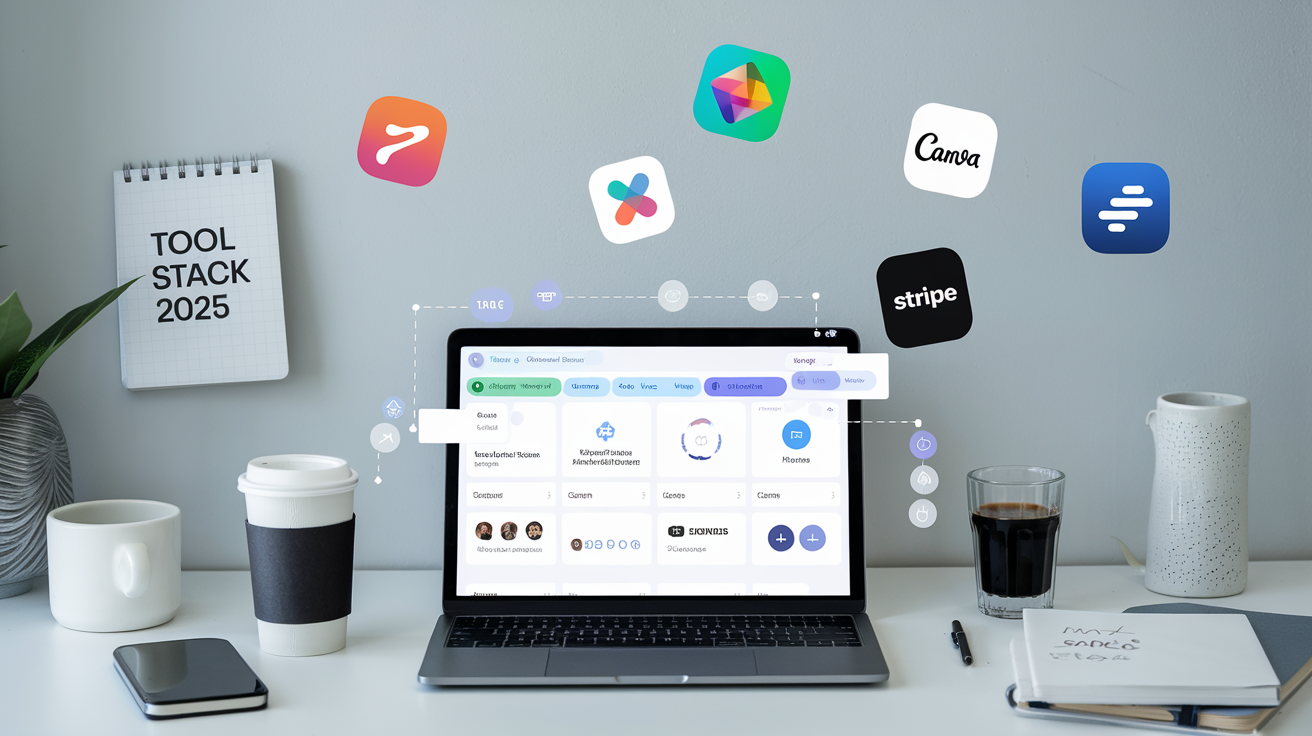Best AI Tools for Content Creators in 2025
The content creation landscape has undergone a revolutionary transformation in 2025, with artificial intelligence becoming an indispensable ally for creators across all industries. From solo bloggers to enterprise marketing teams, AI tools are no longer luxury additions—they’re essential components of modern content strategies that determine success in an increasingly competitive digital ecosystem.
The rapid evolution of AI technology has created unprecedented opportunities for content creators to scale their operations, enhance quality, and maintain consistency while reducing production costs and time investment. This comprehensive guide explores the most powerful AI tools available in 2025, providing detailed insights into their capabilities, practical applications, and strategic implementation for maximum impact.
Understanding the AI Revolution in Content Creation
The integration of artificial intelligence in content creation represents more than technological advancement—it’s a fundamental shift in how creators approach ideation, production, and distribution. Modern AI tools leverage advanced machine learning algorithms, natural language processing, and computer vision to understand context, generate creative solutions, and adapt to individual creator preferences.
The Current State of AI in Content Creation
Content creators in 2025 face unprecedented challenges: algorithm changes that demand constant adaptation, audience expectations for personalized experiences, and the need to maintain consistent output across multiple platforms. Traditional content creation methods, while valuable, often struggle to meet these demands efficiently.
AI tools address these challenges by:
- Automating repetitive tasks that consume valuable creative time
- Generating data-driven insights that inform content strategy
- Providing scalable solutions that grow with creator needs
- Offering quality consistency across large volumes of content
- Enabling rapid iteration and A/B testing of creative concepts
Key Benefits of AI Integration
Enhanced Productivity: AI tools can reduce content creation time by 60-80% while maintaining or improving quality standards. Tasks that previously required hours of manual work—such as keyword research, image sourcing, or video editing—can now be completed in minutes.
Improved Creativity: Rather than replacing human creativity, AI serves as a collaborative partner that suggests alternatives, provides inspiration, and helps overcome creative blocks. This symbiotic relationship often leads to more innovative and engaging content.
Data-Driven Decision Making: AI tools analyze vast amounts of data to provide actionable insights about audience preferences, trending topics, and optimal posting times, enabling creators to make informed strategic decisions.
Cost Efficiency: By automating technical tasks and reducing the need for specialized skills in certain areas, AI tools lower the barrier to entry for high-quality content creation and reduce operational costs.
Top AI Writing and Text Generation Tools
Writing remains the foundation of most content strategies, and AI writing assistants have reached remarkable sophistication in 2025. These tools understand context, maintain voice consistency, and adapt to various writing styles and industries.
Advanced AI Writing Assistants
ChatGPT Plus & Enterprise
- Capabilities: Advanced conversational AI with multimodal support, real-time web browsing, and custom GPT creation
- Best For: Long-form content, research assistance, brainstorming, and complex writing tasks
- Key Features:
- Context retention across long documents
- Code integration for technical content
- Multi-language support with cultural nuance understanding
- Advanced reasoning for complex topics
- Pricing: $20/month for Plus, custom pricing for Enterprise
- Integration: API access, browser extensions, mobile apps
Jasper AI (formerly Jarvis)
- Capabilities: Marketing-focused writing with brand voice training and campaign optimization
- Best For: Marketing copy, advertising content, email campaigns, and social media posts
- Key Features:
- Brand voice analysis and replication
- Campaign performance tracking
- SEO optimization built-in
- Team collaboration features
- Pricing: $49-$125/month based on features and usage
- Integration: CRM systems, social media platforms, content management systems
Claude 4 (Anthropic)
- Capabilities: Advanced reasoning, document analysis, and creative writing with strong safety features
- Best For: Research-heavy content, technical documentation, and analytical writing
- Key Features:
- Superior document comprehension
- Ethical AI guidelines built-in
- Advanced coding assistance
- Academic-level research capabilities
- Pricing: Variable based on usage and model selection
- Integration: API access, developer tools, enterprise solutions
Specialized Writing Tools
Copy.ai
- Focus: Short-form marketing copy and social media content
- Strengths: Quick generation, template variety, A/B testing features
- Best Use Cases: Social media captions, ad copy, product descriptions
Writesonic
- Focus: SEO-optimized content with real-time data integration
- Strengths: Fact-checking, current events integration, landing page optimization
- Best Use Cases: Blog posts, website copy, news articles
Grammarly Business
- Focus: Grammar, style, and tone optimization with team features
- Strengths: Real-time editing, plagiarism detection, brand consistency
- Best Use Cases: Editorial review, team writing projects, professional communications
Implementation Strategies for AI Writing Tools
Workflow Integration: Successful implementation requires integrating AI tools into existing content workflows rather than replacing them entirely. Start with ideation and first drafts, then use human expertise for refinement and strategic oversight.
Voice and Style Training: Most advanced AI writing tools allow custom training on brand voice and style guidelines. Invest time in this setup process to ensure consistent output that aligns with your brand identity.
Quality Control Systems: Establish clear review processes that combine AI efficiency with human oversight. This ensures accuracy, maintains brand standards, and preserves the authentic voice that audiences expect.
Advanced AI Video Production Solutions
Video content continues to dominate digital engagement, and AI video tools have evolved to offer professional-grade capabilities that were previously accessible only to large production teams.
Comprehensive Video Creation Platforms
Synthesia
- Capabilities: AI avatar generation, multilingual video creation, and automated presentation development
- Best For: Training videos, marketing presentations, and educational content
- Key Features:
- 150+ AI avatars with natural movements and expressions
- 120+ language support with accurate pronunciation
- Custom avatar creation from photos
- Brand template integration
- Pricing: $30-$90/month based on video minutes and features
- Use Cases: Corporate training, product demonstrations, international marketing
Pictory
- Capabilities: Script-to-video conversion, long-form video summarization, and automated editing
- Best For: Social media content, educational videos, and marketing campaigns
- Key Features:
- Automatic scene detection and cutting
- Stock footage integration
- Voiceover generation and synchronization
- Branded template creation
- Pricing: $23-$119/month based on video exports and features
- Use Cases: Blog-to-video conversion, social media clips, course content
Runway ML
- Capabilities: Advanced AI video editing with green screen, object removal, and style transfer
- Best For: Creative video projects, artistic content, and experimental filmmaking
- Key Features:
- Real-time video editing
- AI-powered special effects
- Collaborative editing environment
- Advanced motion graphics
- Pricing: $12-$76/month based on processing credits
- Use Cases: Music videos, artistic content, commercial production
Specialized Video Enhancement Tools
Descript
- Focus: Audio and video editing through text-based interface
- Strengths: Transcription accuracy, collaborative editing, overdub technology
- Best Use Cases: Podcasts, interviews, educational content
Loom AI
- Focus: Screen recording with AI-powered editing and enhancement
- Strengths: Automatic editing, transcript generation, viewer analytics
- Best Use Cases: Software tutorials, team communications, product demos
Kapwing
- Focus: Online video editing with AI-powered features
- Strengths: Template variety, collaborative features, social media optimization
- Best Use Cases: Social media content, team projects, quick edits
Video Production Workflow Optimization
Pre-Production Planning: Use AI tools for script generation, storyboard creation, and shot list development. This preparation phase is crucial for efficient production and ensures AI tools can be maximally effective.
Production Efficiency: Leverage AI for real-time editing suggestions, automatic color correction, and audio enhancement during recording sessions. This reduces post-production time significantly.
Post-Production Automation: Implement AI tools for automatic subtitling, chapter generation, and thumbnail creation. These finishing touches are time-consuming manually but can be automated effectively.
Cutting-Edge AI Visual Design Platforms
Visual content creation has been revolutionized by AI tools that can generate, edit, and optimize images with unprecedented speed and quality.
Advanced Image Generation and Editing
DALL-E 3 (OpenAI)
- Capabilities: High-quality image generation from text prompts with improved coherence and detail
- Best For: Custom illustrations, concept art, and unique visual content
- Key Features:
- Improved text rendering within images
- Better prompt adherence and detail accuracy
- Style consistency across image series
- Integration with ChatGPT for iterative refinement
- Pricing: $20/month via ChatGPT Plus or pay-per-use credits
- Use Cases: Blog illustrations, social media graphics, marketing materials
Midjourney V6
- Capabilities: Artistic image generation with exceptional quality and style control
- Best For: Artistic content, brand imagery, and creative projects
- Key Features:
- Superior artistic interpretation
- Advanced style parameter control
- Community-driven learning and sharing
- High-resolution output options
- Pricing: $10-$60/month based on generation limits
- Use Cases: Brand visuals, artistic projects, creative campaigns
Adobe Firefly
- Capabilities: Commercial-safe AI image generation integrated with Creative Cloud
- Best For: Professional design work, commercial projects, and brand content
- Key Features:
- Commercial usage rights included
- Seamless Creative Cloud integration
- Style matching and brand consistency
- Advanced editing and refinement tools
- Pricing: Included with Creative Cloud subscriptions
- Use Cases: Professional design, commercial advertising, brand materials
Comprehensive Design Platforms
Canva AI
- Capabilities: All-in-one design platform with integrated AI features
- Best For: Social media graphics, presentations, and marketing materials
- Key Features:
- Magic Design for instant layouts
- Background removal and replacement
- Brand kit integration and consistency
- Team collaboration and approval workflows
- Pricing: Free tier available, $15-$30/month for advanced features
- Use Cases: Social media content, presentations, marketing collateral
Figma AI
- Capabilities: Design system enhancement with AI-powered prototyping and testing
- Best For: UI/UX design, product development, and team collaboration
- Key Features:
- Automated design system maintenance
- AI-powered user testing insights
- Collaborative design workflows
- Advanced prototyping capabilities
- Pricing: Free tier available, $12-$75/month for teams
- Use Cases: Website design, app interfaces, design systems
Visual Content Strategy Implementation
Brand Consistency: Establish clear visual guidelines and train AI tools to maintain brand standards across all generated content. This includes color palettes, typography choices, and stylistic elements.
Batch Processing: Use AI tools for bulk image processing, resizing, and optimization. This is particularly valuable for social media content that requires multiple formats and sizes.
A/B Testing: Leverage AI to generate multiple visual variations for testing audience preferences and optimizing engagement rates.
Specialized AI Tools for Niche Applications
Beyond general content creation, specialized AI tools address specific challenges in areas like SEO, social media management, podcasting, and analytics.
SEO and Content Optimization
Surfer SEO
- Capabilities: AI-powered content optimization with real-time SERP analysis
- Best For: Blog posts, landing pages, and SEO-focused content
- Key Features:
- Real-time content scoring and optimization
- Competitor analysis and gap identification
- Keyword clustering and content planning
- SERP feature optimization
- Pricing: $89-$239/month based on features and usage
- Use Cases: Content optimization, keyword research, competitive analysis
Clearscope
- Capabilities: Content optimization with semantic keyword analysis
- Best For: Editorial teams, content marketers, and SEO specialists
- Key Features:
- Semantic keyword recommendations
- Content grade scoring
- Team collaboration and workflow management
- Integration with popular writing tools
- Pricing: $170-$750/month based on team size and features
- Use Cases: Content optimization, editorial workflows, SEO strategy
MarketMuse
- Capabilities: Content strategy and planning with AI-powered insights
- Best For: Enterprise content marketing and strategic planning
- Key Features:
- Topic modeling and content gaps analysis
- Competitive content analysis
- Content brief generation
- Performance tracking and optimization
- Pricing: Custom pricing based on needs and usage
- Use Cases: Content strategy, competitive analysis, topic research
Social Media Management and Automation
Buffer AI
- Capabilities: Social media scheduling with AI-powered optimization
- Best For: Multi-platform social media management
- Key Features:
- Optimal posting time recommendations
- AI-generated caption suggestions
- Performance analytics and insights
- Team collaboration features
- Pricing: $6-$120/month based on features and social accounts
- Use Cases: Social media scheduling, content optimization, team management
Hootsuite AI
- Capabilities: Comprehensive social media management with AI insights
- Best For: Enterprise social media operations
- Key Features:
- Advanced analytics and reporting
- AI-powered content recommendations
- Crisis management and monitoring
- Team workflow optimization
- Pricing: $99-$739/month based on features and team size
- Use Cases: Enterprise social media, brand monitoring, team collaboration
Sprout Social
- Capabilities: Social media management with AI-powered customer service
- Best For: Customer service integration and social listening
- Key Features:
- AI-powered customer service responses
- Advanced social listening and sentiment analysis
- Influencer identification and outreach
- Custom reporting and analytics
- Pricing: $249-$399/month based on features and users
- Use Cases: Customer service, social listening, influencer marketing
Podcasting and Audio Content
Riverside.fm
- Capabilities: High-quality podcast recording with AI-powered editing
- Best For: Professional podcast production
- Key Features:
- Local recording for studio quality
- AI-powered editing and enhancement
- Automatic transcription and show notes
- Live streaming capabilities
- Pricing: $15-$24/month based on features and recording hours
- Use Cases: Podcast production, interviews, live streaming
Descript
- Capabilities: Audio editing through text-based interface
- Best For: Podcast editing and audio content creation
- Key Features:
- Text-based audio editing
- Overdub technology for voice synthesis
- Collaborative editing environment
- Automatic transcription and captioning
- Pricing: $12-$30/month based on features and transcription hours
- Use Cases: Podcast editing, audio content creation, transcription
Anchor AI
- Capabilities: Podcast hosting with AI-powered distribution and analytics
- Best For: Podcast distribution and monetization
- Key Features:
- AI-powered audience insights
- Automated distribution to major platforms
- Monetization tools and sponsor matching
- Advanced analytics and reporting
- Pricing: Free tier available, premium features for $5-$20/month
- Use Cases: Podcast hosting, distribution, monetization
Analytics and Performance Optimization
Google Analytics 4 with AI Insights
- Capabilities: Advanced web analytics with machine learning insights
- Best For: Website performance analysis and optimization
- Key Features:
- Predictive analytics and forecasting
- Automated insight generation
- Cross-platform tracking and attribution
- Custom audience creation and targeting
- Pricing: Free tier available, premium features for $150,000/year
- Use Cases: Website optimization, audience analysis, conversion tracking
Hotjar AI
- Capabilities: User behavior analysis with AI-powered insights
- Best For: User experience optimization and conversion rate optimization
- Key Features:
- Automated heatmap analysis
- AI-powered user journey insights
- Conversion funnel optimization
- User feedback analysis and categorization
- Pricing: $32-$171/month based on features and page views
- Use Cases: UX optimization, conversion rate optimization, user research
Strategic Tool Selection and Implementation
Choosing the right combination of AI tools requires careful consideration of workflow requirements, budget constraints, and long-term strategic goals.
Comprehensive Evaluation Framework
Needs Assessment Matrix
Create a detailed assessment of your content creation needs across these dimensions:
| Category | Priority Level | Current Solution | AI Enhancement Opportunity | ROI Potential |
|---|---|---|---|---|
| Writing & Research | High | Manual writing + research | AI writing assistants | 60-80% time savings |
| Visual Design | Medium | Templates + stock photos | AI image generation | 40-60% cost reduction |
| Video Production | High | Outsourced editing | AI video tools | 70-85% cost savings |
| SEO Optimization | Medium | Manual keyword research | AI SEO tools | 50-70% efficiency gain |
| Social Media | Low | Manual scheduling | AI social tools | 30-50% time savings |
Budget Allocation Strategy
Distribute your AI tool budget based on impact potential and current pain points:
- High-Impact Tools (60% of budget): Focus on tools that address your biggest bottlenecks or highest-cost activities
- Efficiency Tools (25% of budget): Invest in tools that automate routine tasks and free up creative time
- Experimental Tools (15% of budget): Reserve budget for testing new tools and emerging technologies
Integration Planning
Successful AI tool implementation requires careful integration planning:
- Workflow Mapping: Document current processes and identify integration points
- Training Requirements: Assess team training needs and create learning schedules
- Data Migration: Plan for transferring existing content and templates to new tools
- Quality Assurance: Establish review processes to maintain standards during transition
Team Adoption and Training
Gradual Implementation Strategy
Implement AI tools gradually to minimize disruption and maximize adoption:
- Phase 1 (Weeks 1-4): Introduce one primary tool with comprehensive training
- Phase 2 (Weeks 5-8): Add complementary tools that integrate with the primary platform
- Phase 3 (Weeks 9-12): Expand to specialized tools and advanced features
- Phase 4 (Ongoing): Optimize workflows and explore new capabilities
Training and Support Systems
Develop comprehensive training programs that include:
- Tool-specific tutorials: Hands-on training for each AI platform
- Workflow integration: How to incorporate AI tools into existing processes
- Quality standards: Maintaining brand consistency and content quality
- Troubleshooting guides: Common issues and solutions for each tool
Change Management
Address resistance to AI adoption through:
- Clear communication: Explain benefits and address concerns openly
- Involvement in selection: Include team members in tool evaluation and selection
- Success metrics: Track and share productivity improvements and quality gains
- Ongoing support: Provide continuous learning opportunities and advanced training
Cost-Benefit Analysis and ROI Measurement
Direct Cost Savings
Calculate immediate savings from AI tool implementation:
- Reduced outsourcing costs: Compare AI tool subscriptions to freelancer/agency fees
- Time savings: Quantify hours saved and multiply by hourly rates
- Increased output: Measure volume increases without proportional cost increases
- Quality improvements: Assess reduced revision cycles and client satisfaction
Revenue Impact
Measure revenue improvements from AI implementation:
- Increased content volume: More content can lead to higher engagement and sales
- Improved SEO rankings: Better optimization can drive organic traffic growth
- Enhanced quality: Higher-quality content can improve conversion rates
- Faster time-to-market: Quicker content production can capture timely opportunities
Long-term Strategic Benefits
Consider long-term advantages that may not show immediate ROI:
- Competitive advantage: Early adoption of AI tools can differentiate your brand
- Scalability: AI tools enable growth without proportional increases in overhead
- Innovation capacity: Freed creative time can be invested in strategic initiatives
- Market positioning: AI-enhanced content can position your brand as forward-thinking
Future Trends and Emerging Technologies
The AI landscape for content creation continues to evolve rapidly, with several emerging trends that will shape the industry in the coming years.
Advanced AI Capabilities on the Horizon
Multimodal AI Integration
The future of AI content creation lies in seamless integration across multiple content formats:
- Unified content creation: Single platforms that can generate text, images, video, and audio from single prompts
- Cross-format optimization: AI that understands how content performs across different formats and platforms
- Automatic format adaptation: Content that automatically adjusts for different platforms and audiences
- Interactive content generation: AI that can create engaging, interactive experiences
Personalization at Scale
Advanced AI will enable unprecedented personalization capabilities:
- Individual audience targeting: Content tailored to specific audience segments or individuals
- Dynamic content adaptation: Real-time content modification based on user behavior and preferences
- Predictive content creation: AI that anticipates content needs based on trends and user data
- Emotional intelligence: AI that understands and responds to audience emotional states
Real-time Collaboration
Future AI tools will enhance collaborative content creation:
- Simultaneous multi-user editing: Real-time collaboration with AI assistance for multiple creators
- Intelligent workflow management: AI that optimizes task distribution and project timelines
- Automated quality assurance: Real-time content review and optimization during creation
- Cross-platform synchronization: Seamless content sharing and adaptation across platforms
Emerging Technology Integration
Voice and Conversational AI
Voice-activated content creation will become increasingly sophisticated:
- Natural voice interfaces: Creating content through conversational commands
- Voice cloning and synthesis: Generating audio content in specific voices or styles
- Multilingual voice generation: Creating content in multiple languages with native pronunciation
- Emotional voice modulation: Adjusting tone and emotion in generated audio content
Augmented and Virtual Reality
AI will power immersive content experiences:
- 3D content generation: Creating virtual environments and objects from text descriptions
- Interactive storytelling: AI-powered narrative experiences that adapt to user choices
- Virtual presenter creation: Realistic avatars for presentations and educational content
- Immersive brand experiences: Creating virtual spaces and experiences for marketing
Blockchain and NFT Integration
AI-generated content will integrate with blockchain technologies:
- Content authenticity verification: Blockchain-based proof of AI-generated content
- Automated rights management: Smart contracts for content licensing and usage
- Decentralized content creation: Community-driven AI content generation platforms
- Value attribution: Fair compensation for AI-assisted content creation
Preparing for the Future
Skill Development Focus Areas
Content creators should focus on developing skills that complement AI capabilities:
- AI prompt engineering: Learning to communicate effectively with AI systems
- Strategic thinking: Focusing on high-level strategy while AI handles tactical execution
- Creative direction: Guiding AI tools to achieve specific creative visions
- Data analysis: Understanding and interpreting AI-generated insights and recommendations
Technology Monitoring
Stay informed about emerging AI technologies:
- Industry publications: Follow AI and marketing technology publications
- Conference attendance: Participate in AI and content marketing conferences
- Beta testing: Join beta programs for new AI tools and platforms
- Community engagement: Participate in AI and content creator communities
Ethical Considerations
Prepare for ethical challenges in AI content creation:
- Transparency requirements: Disclosing AI assistance in content creation
- Bias mitigation: Ensuring AI-generated content is fair and inclusive
- Authenticity preservation: Maintaining human creativity and unique voice
- Privacy protection: Safeguarding user data in AI-powered content creation
Best Practices and Optimization Strategies
Maximizing the value of AI tools requires strategic implementation and ongoing optimization.
Content Quality Assurance
Establishing Quality Standards
Create clear guidelines for AI-generated content:
- Brand voice consistency: Develop and maintain brand voice guidelines that AI tools can follow
- Accuracy verification: Implement fact-checking processes for AI-generated content
- Originality checks: Use plagiarism detection tools to ensure content uniqueness
- Audience appropriateness: Review AI content for target audience alignment
Review and Editing Workflows
Develop efficient review processes:
- Multi-stage review: Implement technical, creative, and strategic review stages
- Collaborative editing: Use tools that allow multiple stakeholders to review and approve content
- Version control: Maintain clear version histories for AI-generated content
- Performance tracking: Monitor how AI-generated content performs compared to human-created content
Continuous Improvement
Optimize AI tool performance over time:
- Performance analytics: Track key metrics for AI-generated content
- A/B testing: Compare AI-generated content with human-created alternatives
- Tool optimization: Regularly update AI tool settings and parameters
- Training data refinement: Improve AI outputs by refining training data and prompts
Workflow Optimization
Automation Opportunities
Identify processes that can be automated:
- Content ideation: Use AI for topic suggestions and content planning
- Research assistance: Automate initial research and fact-gathering
- Format adaptation: Automatically convert content between formats
- Distribution optimization: Automate posting schedules and platform-specific formatting
Human-AI Collaboration
Optimize the balance between human creativity and AI efficiency:
- Strategic oversight: Maintain human control over strategic decisions and creative direction
- Iterative refinement: Use AI for initial drafts and human expertise for refinement
- Quality assurance: Combine AI efficiency with human judgment for final quality checks
- Creative enhancement: Use AI to enhance human creativity rather than replace it
Process Documentation
Document optimized workflows for consistency:
- Standard operating procedures: Create detailed guides for AI tool usage
- Template libraries: Develop reusable templates and prompts for common content types
- Best practice guides: Document successful strategies and common pitfalls
- Training materials: Create resources for new team members and ongoing education
Security and Privacy Considerations
Data Protection
Implement robust data protection measures:
- Data encryption: Ensure all data transmitted to AI services is encrypted
- Access controls: Limit AI tool access to authorized personnel only
- Data retention policies: Understand and comply with AI service data retention policies
- Backup procedures: Maintain backups of important content and data
Privacy Compliance
Ensure compliance with privacy regulations:
- GDPR compliance: Understand European privacy requirements for AI tool usage
- CCPA compliance: Comply with California privacy regulations
- International regulations: Stay informed about privacy requirements in target markets
- Client confidentiality: Protect client information when using AI tools
Intellectual Property Protection
Safeguard intellectual property rights:
- Copyright considerations: Understand copyright implications of AI-generated content
- Trademark protection: Ensure AI-generated content doesn’t infringe on trademarks
- Original content attribution: Properly attribute AI assistance in content creation
- Licensing agreements: Understand the terms of AI tool licensing agreements
Performance Measurement and Optimization
Key Performance Indicators
Track relevant metrics for AI tool effectiveness:
- Productivity metrics: Measure time savings and output increases
- Quality metrics: Track content quality scores and audience engagement
- Cost efficiency: Monitor cost per piece of content and overall budget utilization
- Revenue impact: Measure how AI-enhanced content affects business outcomes
Analytics and Reporting
Develop comprehensive reporting systems:
- Dashboard creation: Build dashboards that track AI tool performance
- Regular reporting: Create monthly and quarterly reports on AI tool ROI
- Trend analysis: Identify patterns and trends in AI tool effectiveness
- Benchmarking: Compare performance against industry standards and competitors
Continuous Optimization
Regularly optimize AI tool usage:
- Performance reviews: Conduct quarterly reviews of AI tool effectiveness
- Strategy adjustments: Modify approaches based on performance data
- Tool updates: Stay current with AI tool updates and new features
- Training updates: Provide ongoing training to maximize tool effectiveness
Conclusion
The AI revolution in content creation is not just changing how we work—it’s redefining what’s possible for creators at every level. As we’ve explored throughout this comprehensive guide, the tools available in 2025 offer unprecedented opportunities to enhance creativity, improve efficiency, and scale content operations in ways that were unimaginable just a few years ago.
The key to success lies not in adopting every available AI tool, but in thoughtfully selecting and implementing solutions that align with your specific needs, workflow, and strategic objectives. Whether you’re a solo creator looking to compete with larger teams or an enterprise seeking to optimize content operations, the right combination of AI tools can provide significant competitive advantages.
As we look toward the future, it’s clear that AI will continue to evolve, offering even more sophisticated capabilities and seamless integration opportunities. The creators who invest in understanding and implementing these tools today will be best positioned to leverage tomorrow’s innovations.
The journey of AI adoption in content creation is ongoing, and the landscape will continue to shift rapidly. By staying informed about emerging technologies, maintaining focus on quality and authenticity, and continuously optimizing workflows, content creators can harness the full potential of AI while preserving the human creativity that makes content truly engaging and valuable.
The future of content creation is here, and it’s powered by the thoughtful integration of human creativity and artificial intelligence. The question isn’t whether to adopt AI tools, but how quickly and effectively you can implement them to achieve your content creation goals.






